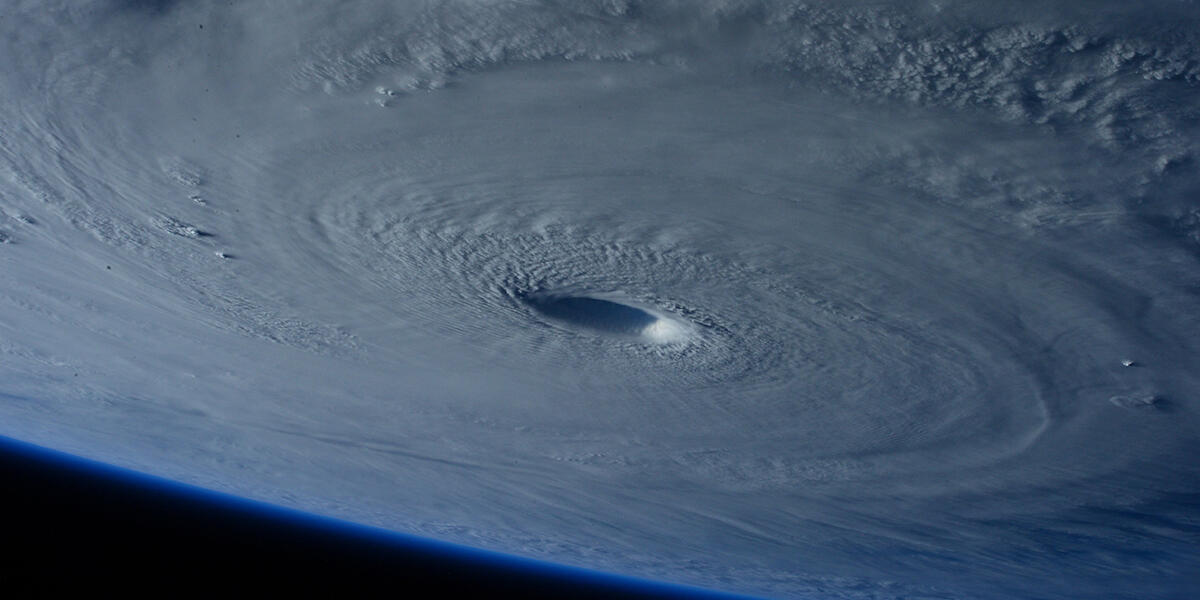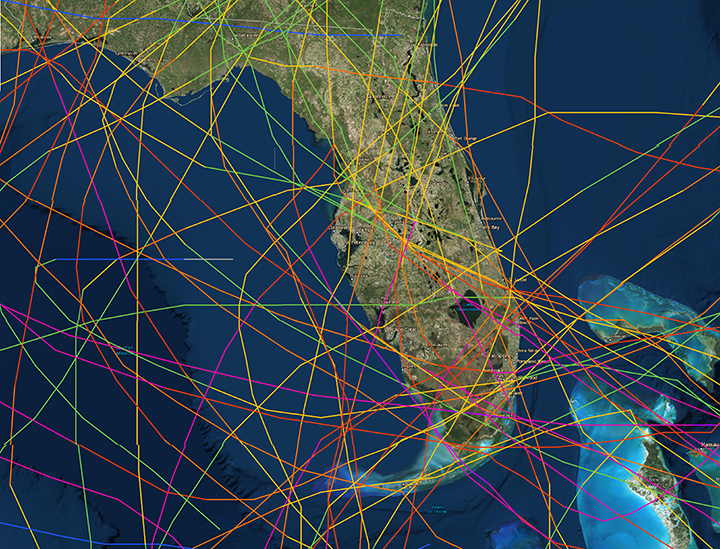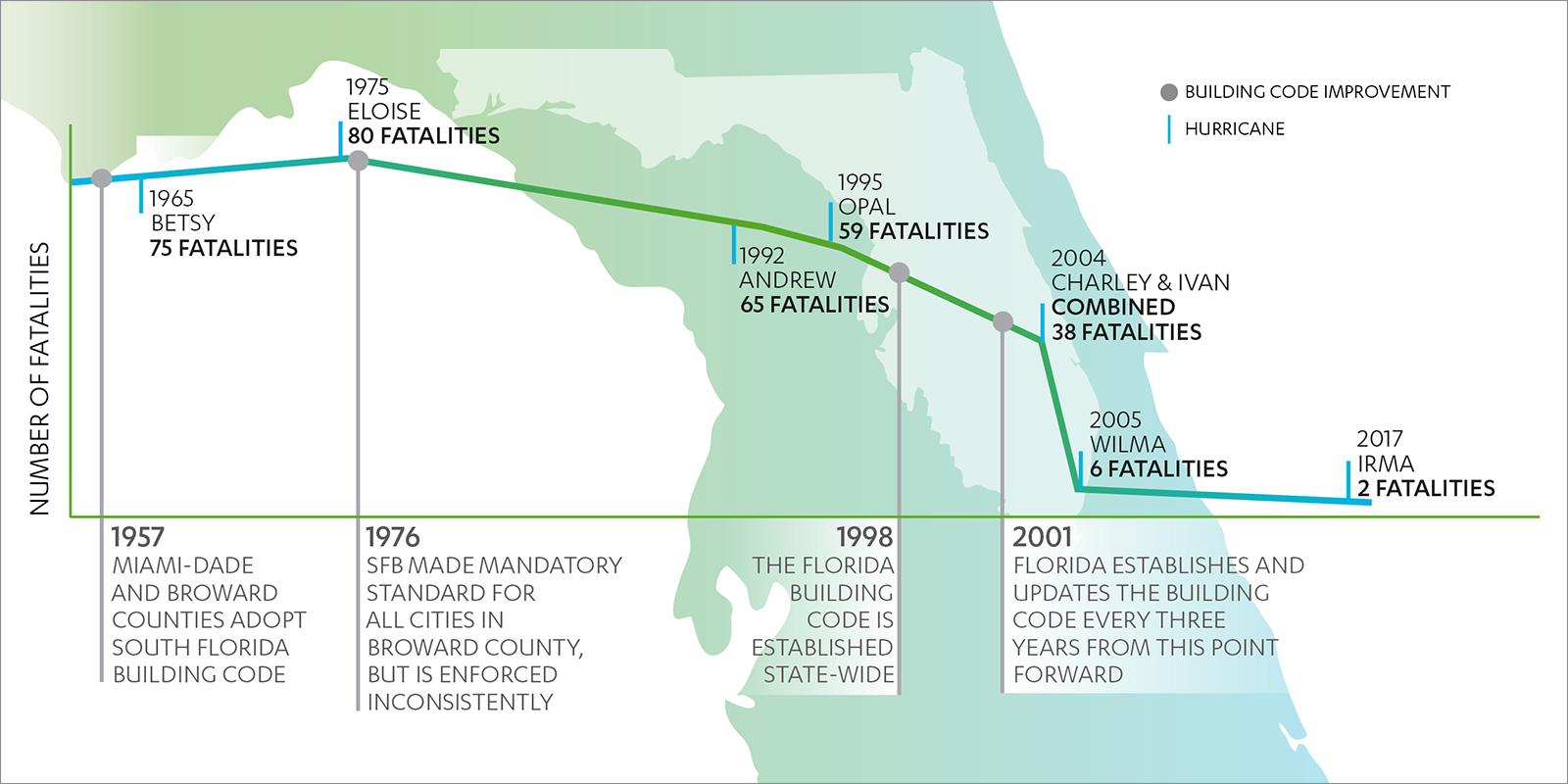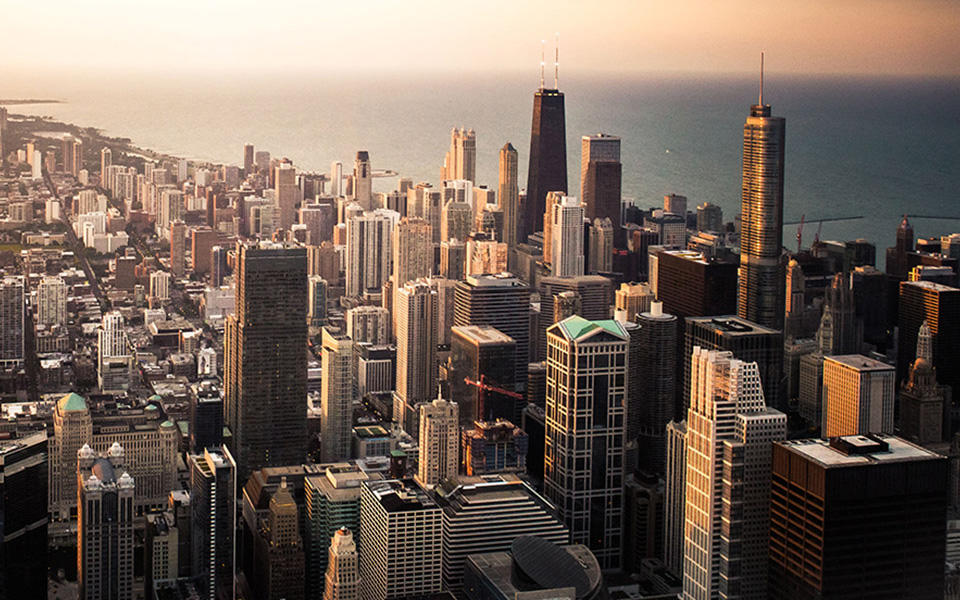High performance & sustainability
How extreme weather events evolve our building codes and regulations
Extreme weather events, such as the multiple hurricanes that came through in August and September, put buildings to the test. They provided protection and saved people's lives. While it is important to understand what didn’t work, we like to focus on what did work and what needs to continue to work. According to The Lancet report Countdown, there has been a 46 percent increase in the number of weather-related disasters from 2000 to 2016.
How does a hurricane in Texas influence our buildings in the Midwest? Even though it turns into a tropical storm by the time it reaches us, hurricanes still provide an opportunity to learn and improve so our buildings withstand the weather events that we are more likely to experience here. As storms are becoming more frequent and fierce, we in the building industry need to focus on resilience and improving our cities, towns, buildings and infrastructure so they can endure the storms to come.
We also need to understand that the immediate impact of a weather event on the construction industry extends far beyond the coasts. When these events hit, and hit hard, we are all affected. Insurance rates go up, material prices go up and the labor force is impacted as well. And when construction is happening all over the country and construction prices go up because a hurricane came through some 500 miles away, that puts stress on our clients.
Built to last
On September 10 of this year, Hurricane Irma directly hit a condo building in Miami, Florida, with 53 MPH winds and gusts up to 100 MPH, and the building stood without a scratch. The landscaping was pretty beat up, but everyone inside was safe and could go on with their lives the next day. Another building in the same community didn’t fare so well, and the people in that building were displaced, stressed and are still dealing with the after-effects. Which scenario would you want to be in? Of course, the first one. You want to survive the storm. You want your building to survive the storm. You want to move on with your life as quickly as possible.
Philippe Houdard, a resident of Miami’s Brickell financial district who rode out Irma in his 16th-floor condo in a tower built after the new code took effect, said he felt secure throughout the storm: “At no point were the windows rattling,” he said. “I didn’t feel vulnerable.”
So, what about the buildings that actually survived those 100 to 150 MPH winds, made them come out unscathed? What did those buildings have that the others did not? They were built to meet more stringent building codes.
Think of the story of the three little pigs: the first pig built cheaply and quickly with hay, the second put a little more investment in with sticks, but it was the third little pig that put in the work for the strong brick house that stood up again the wolf's powerful blow. Building codes ensure the right materials and installation practices are used, which could have prevented the destruction of the first two houses.
What is the connection between extreme weather events and building codes? As we look ahead to the future, what have we learned from these catastrophic events?
History and costs of hurricanes
For the last 100 years, there have been 56 hurricanes, Category 1-5, making landfall in Florida since 1916. The graph below illustrates the paths of these hurricanes. Green indicates Cat 1, while purple represents Cat 5.
In an average year, there are 10 tropical storms (six of which become hurricanes) and more than 1,200 tornadoes touch down. In South Florida, Hurricane Andrew (Cat 5) cost $25 billion in property damage and killed 44 people. In 2005, Hurricane Katrina (Cat 3) cost us $108 billion in property damage and killed 1,833 people. In 2012, Hurricane Sandy (Cat 1) resulted in $65 billion in damage.
This year, Hurricane Harvey (Cat 4) is estimated at $80 billion in property damage and Hurricane Irma (Cat 4) is estimated up to $65 billion in property damage. This is the first year on record that the continental United States has experienced two Category 4 hurricane landfalls in the same year. Hurricane Maria (Cat 4), which hit U.S. territory Puerto Rico, is estimated around $85 billion in property damage, and the island is still reeling from the after-effects.
Influencing how we build
How do we plan and build to withstand these fierce storms and minimize as much damage as possible? One way is through regulation. Florida building codes are published on a three-year cycle. It is then up to local jurisdictions to either adopt them or not, or adopt them with amendments. After Hurricane Andrew, Florida adopted a new building code with several amendments aimed at hurricane protection.
Naturally, the insurance agencies are huge advocates when it comes to minimizing risk and exposure. Their interest ensures building codes are not arbitrary and have the most impact on the resilience of these structures. The Florida Building Code, for example, stems from the devastating effects of Hurricane Andrew, a Category 5 storm that hit in 1992. The code's purpose is to protect lives, help reduce property losses in a storm and provide a guide for insurance companies to determine rates.
As weather patterns change and there is an increase in the number of powerful storms, the building industry and the insurance industry are demanding higher building performance, which raises the bar for everyone. Due to its level of life-safety stringency, Miami-Dade's requirements have become widely used as the reference point throughout Florida and beyond. From a life-safety standpoint, the demonstration of product compliance for use in the High Velocity Hurricane zone is critical. It is usually after tragedies that these codes are updated or amended.
The International Code Council (ICC) has developed the most widely adopted set of codes to unify the country's building regulatory systems. Federal Emergency Management Agency (FEMA) and National Oceanic and Atmospheric Administration (NOAA) also provide guidance to on how to design buildings to lessen the impact of natural disasters. The Fortified for Safer Business program of the Insurance Institute for Business and Home Safety (IBHS) offers design criteria and construction methods that increase a new commercial building's durability and resilience to natural disasters.
Because of Hurricane Andrew, one of the first standards Florida adopted was the wind provisions from the American Society of Civil Engineers' (ASCE) standards, which encompasses the national standard for wind requirements. One of the most important additions to the code was the requirement of missile-impact resisting glass, which can withstand high velocity impact from wind-borne debris during a hurricane. The code also established new standards for roofing, created more thorough inspection processes and required that building products used meet approved hurricane standards. Laws were even passed that require supermarkets, gas stations and hospitals to be equipped with generators so they can reopen quickly after a storm.
Hurricane Katrina shaped the national dialogue on building for flood resistance. It not only led to improved resilience in the impacted area but led to greater resilience in national model codes and best practices for flood and wind mitigation. Prior to Hurricane Katrina, Alabama, Louisiana, and Mississippi did not have statewide building codes for nonstate-owned buildings. Many of the communities in the area had either not adopted up-to-date model building codes that incorporated flood and wind protection, or they had no building codes at all.
Soon after Hurricane Katrina, FEMA issued advisory base flood elevation (ABFE) maps so that rebuilt and retrofitted buildings would be raised to an elevation that would protect buildings from damage in future storms. On August 1, 2015, University Medical Center opened in New Orleans to replace the Katrina-damaged Charity Hospital. In line with many Katrina MAT recommendations and FEMA best practices, the state-of-the-art hospital located all critical functions 21 feet or more above the Base Flood Elevation (BFE) and has backup power to make it fully operational in a power outage for up to one week. The exterior is also designed to resist the effects of high wind.
In the Northeast, Hurricane Sandy crippled the transit systems, hospitals could not function and public-housing communities had no working boilers or elevators. New building code requirements require residential buildings five stories or higher to add faucets in common areas like laundry rooms. This gives residents on higher floors access to water for drinking and other uses so they can stay in a larger building for an extended period of time if the power goes out.
New Jersey’s building code was modified to refer to ASCE 24, Flood Resistant Design and Construction, for all buildings on pile foundations, adding a requirement for flood zone special inspections in New York City, and consideration of adding a requirement of 2 feet of freeboard (additional height above design flood elevation) for the elevation of non-residential buildings in New York State.
New York's Con Edison's power plant built a fortress of a utility power plant. Serving 250,000 customers, including the banks on Wall Street, public-housing communities and the L subway line from Brooklyn, the utility provider has undergone tremendous upgrades since Hurricane Sandy. Much of the critical equipment has been raised 35 feet. A second-story control room replaced the original at ground level and 45 doorways were outfitted with 10-foot-tall Kevlar curtains that can be deployed in minutes. The company also installed a submarine door to seal off a tunnel that runs underneath it. Their entire goal is to remain in service if another Sandy hits.
Preparing now for the next storm
What are the innovative approaches to preparing for these storms? We are seeing planning and very innovative thought processes take place. We are better prepared today than we were yesterday but there is more work to be done. As these storms become more intense and frequent we can't wait until after tragedy strikes to reboot and rebuild. The idea of resilience is to plan and be prepared to take these storms on and recover quickly.
Let's look at what the architects are doing. Net zero buildings are on the rise. Today we have the technology for buildings to produce all the energy and collect all the water they need without depending on the grid. The U.S. Department of Energy has designated eight climate zones in the U.S., and there are net zero buildings in each zone except for the Sub-Arctic zone in Alaska. At the end of 2016, there were 332 net zero buildings in North America. All building typologies are represented with K-12 making up the largest portion followed by offices.
Typically, a net zero building involves a significant upfront investment when compared to a conventional building. However, the economics of net zero are changing, and we are seeing that the investment to build a net zero building is about half of what it was three or four years ago. Net zero buildings are often being designed to not only produce their own power, but demand less energy overall than a conventional building, which allows them to serve as micro power plants for other buildings, if needed. Think of it as your neighbor letting you siphon off their generator when a storm knocks out your power. As buildings start to stand on their own, it lessens the dependency on the community's infrastructure. Therefore, if a natural disaster hits, the building can automatically turn back on when the sun comes out again.
Another design challenge looks at building program stacking. Typically, the guts of the building - the mechanical room and boiler room – are located either at the ground level or in a basement. Increased flooding and storm surges have forced designers to look at this differently. If we want the building to remain operational, then we cannot put the equipment that powers the building on levels prone to flooding. Building owners and developers, especially in New York, are looking at moving the electrical and mechanical rooms to the second floor or even the roof. While this sacrifice this sellable space, the return of investment (ROI) comes in the form of marketability and provides an edge in the market because tenants appreciate the extra precautions.
After every natural disaster, building materials and labor are in high demand, so prices rise. Do some materials fare better than others in a hurricane? Yes. Some of the more affordable materials are often permeable or lightweight, and they take quite a beating and need replaced after a storm. Others, like High Performance Concrete (HPC), continue to gain popularity for strength and durability of performance. If we build with these stronger, more durable materials that withstand hurricane-strength winds and storm surges, we won’t have to rebuild after the storm.
Conclusion
When disasters like these hit, we have seen that high performing buildings fare better. First and foremost, they save lives. They also sustain minor damage, which allows the buildings and the people in them to rebound more quickly. And they make people feel safe.
High performing buildings require more of an upfront investment, but it’s important to consider your risks over both the short and long term. With every natural disaster, local regulations and how we design and build buildings will get more robust, but it is for everyone's benefit. We can't force clients to make resilient choices, but we can introduce them to products that make a difference and present the most comprehensive information possible so they make the most informed decisions possible.
Resources
Climate Change's impact on human health is already here-and is potentially irreversible, USA Today, Doyle Rice, October 20, 2017
http://weatherplus.blog.palmbeachpost.com/2017/09/22/initial-irma-report-confirms-hurricane-force-gusts-in-palm-beach-county/
Homes Built to Stricter Standards Fared Better In Storm, Wall Street Journal Article, 09/16/17, Laura Kusisto and Arian Campo-Flores
NOAA
Specifying More Resilient Buildings by Andrew Pinneke, January 2015
Hurricane Andrew prompted better building code requirements, Business Insurance, Mike Tsikoudakis, 08/19/2012
After Andrew, Florida Changed Its Approach to Hurricanes, The New York Times, Lizette Alvarez and Marc Santora, September 6, 2017
Did Katrina change the way we build? A Building Science perspective, News and Views Associate of State Floodplain Managers, John Ingargiola and Laura Ghorbi, August 2015
Building Code Changes Resulting from FEMA's Hurricane Sandy Mitigation Assessment Team Report, American Society of Civil Engineers (ASCE) Library, John Ingargiola, Adrienne Sheldon, and Laura Ghorbi 2015
5 years After Sandy are we Better Prepared? , Patrick McGeehan and Winnie Hu, The New York Times, 10/30/2017
The Climate is Changing, so must architecture, Architect Magazine, Ned Cramer, October 2017
About the Author






